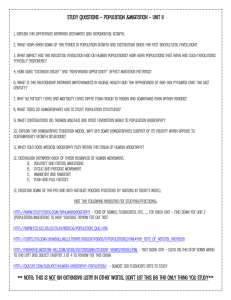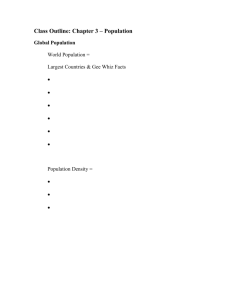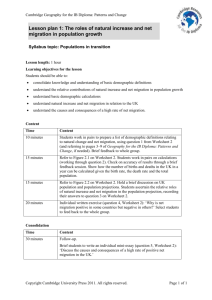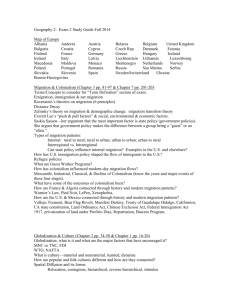AP HUMAN GEOG
advertisement
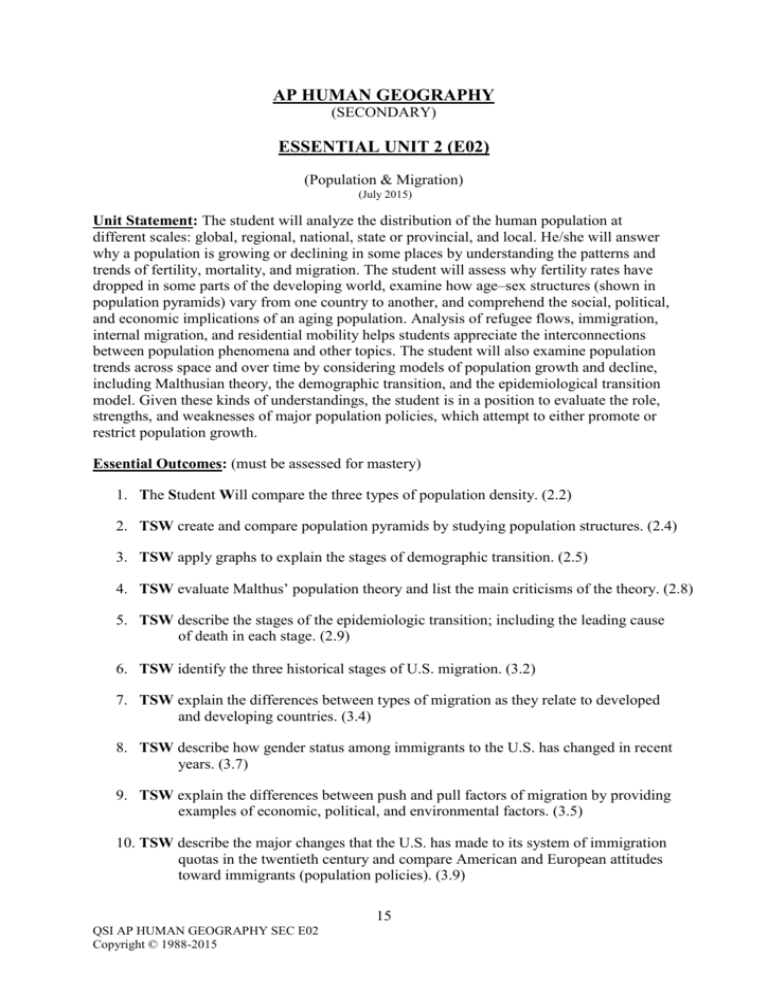
AP HUMAN GEOGRAPHY (SECONDARY) ESSENTIAL UNIT 2 (E02) (Population & Migration) (July 2015) Unit Statement: The student will analyze the distribution of the human population at different scales: global, regional, national, state or provincial, and local. He/she will answer why a population is growing or declining in some places by understanding the patterns and trends of fertility, mortality, and migration. The student will assess why fertility rates have dropped in some parts of the developing world, examine how age–sex structures (shown in population pyramids) vary from one country to another, and comprehend the social, political, and economic implications of an aging population. Analysis of refugee flows, immigration, internal migration, and residential mobility helps students appreciate the interconnections between population phenomena and other topics. The student will also examine population trends across space and over time by considering models of population growth and decline, including Malthusian theory, the demographic transition, and the epidemiological transition model. Given these kinds of understandings, the student is in a position to evaluate the role, strengths, and weaknesses of major population policies, which attempt to either promote or restrict population growth. Essential Outcomes: (must be assessed for mastery) 1. The Student Will compare the three types of population density. (2.2) 2. TSW create and compare population pyramids by studying population structures. (2.4) 3. TSW apply graphs to explain the stages of demographic transition. (2.5) 4. TSW evaluate Malthus’ population theory and list the main criticisms of the theory. (2.8) 5. TSW describe the stages of the epidemiologic transition; including the leading cause of death in each stage. (2.9) 6. TSW identify the three historical stages of U.S. migration. (3.2) 7. TSW explain the differences between types of migration as they relate to developed and developing countries. (3.4) 8. TSW describe how gender status among immigrants to the U.S. has changed in recent years. (3.7) 9. TSW explain the differences between push and pull factors of migration by providing examples of economic, political, and environmental factors. (3.5) 10. TSW describe the major changes that the U.S. has made to its system of immigration quotas in the twentieth century and compare American and European attitudes toward immigrants (population policies). (3.9) 15 QSI AP HUMAN GEOGRAPHY SEC E02 Copyright © 1988-2015 Practiced/Ongoing Outcomes: (not formally assessed) 1. The Student Will Interpret maps and analyze geospatial data. 2. TSW understand and explain the implications of associations and networks in places. 3. TSW recognize and interpret the relationships among patterns and processes at different scales of analysis. 4. TSW define regions and evaluate the regionalization process. 5. TSW characterize and analyze changing interconnections among places. Key Terms and Concepts: (also look at Ch.2 & Ch.3 glossary) Population densities Demograph ic regions Population distributions Natality (pro/anti) Mortality Population explosion Thomas Malthus Zero population growth Diffusion of fertility control Age distribution Disease diffusion Population pyramid Maladaptation Cohort Sex ratio Gendered space Standard of living Sustainability Epidemiological Transition Dependency ratio Rate of natural increase J-curve / S-curve Ecumene Carrying capacity Population projection Neo-Malthusian Push-pull factors Forced Migration intercontinental interregional intraregional internal rural-urban Space-time prism Gravity model Distance decay Step migration Chain migration Refugee Migrations patterns Transmigra tion Doubling time Infant mortality rate Demographic Transition model Suggested Materials/Resources: Rubenstein, Chapter 2 and 3: “Population” and “Migration” Kuby, Harner, and Gober, Chapter 3, 4, 5: “Tracking the Aids Epidemic in the United States: Diffusion through Space and Time”; Newton’s First Law of Migration: The Gravity Model”; “One Billion and Counting: The Hidden Momentum of Population Growth in India” Rosling, Hans. Video: Don’t Panic: The Truth About Population. Wingspan Productions, BBC. Pearson’s Human Geography video series, “Kill or Cure” and “The Real Leap Forward” Pearson Online Support via www.MasteringGeography.com Technology Links: WebPath Express (found in school library) Population Pyramids and Demographic Data by Country http://www.census.gov/ipc/www/idb/country.php Developing Sampling Techniques http://www.census.gov/history/www/innovations/data_collection/developing_sampling_t echniques.html 16 QSI AP HUMAN GEOGRAPHY SEC E02 Copyright © 1988-2015 Boom or Bust? The Economic Effects of the Baby Boom http://research.stlouisfed.org/publications/review/94/09/Boom_Sep_Oct1994.pdf Pro-Natalist Commercial for Singapore: https://www.youtube.com/watch?v=8jxU89x78ac Census Bureau: http://www.census.gov/ Ravenstein’s Law of Migration: http://www.csiss.org/classics/content/90 Ravenstein’s Law of Migration: http://blog.lib.umn.edu/globerem/main/Ravenstein.pdf Ravenstein, E.G. (1885). The Laws of Migration. Journal of the Statistical Society of London. Vol. 48. No. 2. pp. 167–235. Blackwell Publishing for the Royal Statistical Society. http://smithsonianeducation.org/migrations/start.html Immigration Acts: http://www.umass.edu/complit/aclanet/USMigrant.html Hunte, C. K. (2004). Workers’ remittances, remittance decay and financial deepening in developing countries. American Economist, 48(2), 82+. Retrieved December 25, 2005, from Questia database: http://www.questia.com/PM.qst?a=o&d=5008547806 Migration Information Source: www.migrationinformation.org Pew Hispanic Center: http://pewhispanic.org/reports/ Information on Refugees: www.refugees.org Suggested Assessment Tools and Strategies: Students will compare a Sub-Saharan country and a More Developed Country (MDC) of their choice be researching and creating a presentation with population pyramids with analysis of their country in the demographic transition and any patterns or anomalies, along with information regarding population policies (pro-natalist/antinatalist), education equality, family planning and health care of each country – explain to the class how certain characteristics have helped it progress or move slowly through the demographic transition. Students will compare two countries’ migration patterns. One country must encourage internal migration while the other has limitations or restrictions. Students will examine these countries further by looking at their immigration policies, quotas, by refugee and work patterns – all to be composed into a visual presentation. Country Problem Population Policy Problems/Solution/Degree of Success Japan India China Discuss the distribution of world population. Emphasize that the densest populations are found mostly in Asia and in Europe. Other population clusters include the northeastern region of the United States. 17 QSI AP HUMAN GEOGRAPHY SEC E02 Copyright © 1988-2015 Select two contrasting countries from the following website. http://www.census.gov/ipc/www/idb/country.php You can use Benin and Denmark, and use the data for 2009 or 2010. Have the students plot a population pyramid using graph paper, then answer the following questions: a. Compare and contrast the demographic characteristics of Benin and Denmark using the population pyramids you created. b. Explain the relationship between the structure of the population and economic development for both nations. How can this structure be both negative and positive for both nations? c. At what stage of the demographic transition model would you place each nation? Explain. Discuss population policies and issues in the world today. You may assign the following chart as class work. POLITICAL ECONOMIC ENVIRONMENTAL Students could interview an internal or international immigrant about the push/pull factors that influenced their migratory decision. Write up their interview findings as an essay. Include: o the type of migration: forced or voluntary, permanent or temporary, internal or external o an evaluation of the extent the migration applies to Ravenstein’s law of migration PUSH–PULL FACTORS Group the reasons people migrate in the chart above. Students should say whether their movement was because of push or pull factors. Use the following as a template or create your own. Ask students to trace the three phases of immigration in the United States. To extend your discussion, you may ask students about the impact of each group on the United States. PHASES OF MIGRATION TO THE UNITED STATES, 17TH CENTURY TO PRESENT TIME PERIOD ORIGIN APPROXIMATE NUMBERS = Write a summary/reaction to film. The summary and response should not be more than two pages. You may have to give an introduction and additional instructions. Teacher created assessments 18 QSI AP HUMAN GEOGRAPHY SEC E02 Copyright © 1988-2015 Teacher Observation Teacher created assessments Teacher Observation Generated Tests from textbook Previous AP Exam Questions Student created projects/presentations RUBRIC FOUND ON THE FOLLOWING PAGE……………………. 19 QSI AP HUMAN GEOGRAPHY SEC E02 Copyright © 1988-2015 AP HUMAN GEOGRAPHY Suggested Essential Unit 2 (E02) Rubric: Name _____________________________________Class________ Date _______________ • All TSW’s must be mastered for a ‘B’. • 3 of 5 ‘A’-level blocks should be met for an ‘A’. • Teachers may choose to use their own rubrics; however, all TSWs must be assessed. TSW ‘A’ Above Mastery ‘B’ Mastery 1. compare the three types of compare the three types of compare the three types of population density population density using detailed population density information 2. create and compare create and compare population create and compare population population pyramids by pyramids by studying population pyramids by studying population studying population structures, effectively pointing structures structures out patterns 3. explain the stages of explain the stages of demographic explain the stages of demographic transition of transition of countries using demographic transition of countries using graphs graphs effectively pointing out countries using graphs transitions 4. evaluate Malthus’ population evaluate Malthus’ population theory and list the main theory and list the main criticisms criticisms of the theory of the theory by arguing in favor for or against 5. describe the stages of the epidemiologic transition including the leading cause of death in each stage 6. identify the three historical stages of U.S. migration 7. explain the differences between different types of migration as they relate to developed and developing countries 8. describe how gender status among immigrants to the U.S. has changed in recent years 9. explain the differences between push and pull factors of migration by providing examples of economic, political and environmental factors evaluate Malthus’ population theory and list the main criticisms of the theory describe the stages of the epidemiologic transition including the leading cause of death in each stage identify the three historical stages of U.S. migration explain the differences between different types of migration as they relate to developed and developing countries describe how gender status among immigrants to the U.S. has changed in recent years explain the differences between push and pull factors of migration by providing examples of economic, political and environmental factors comparing different regions 10. describe the major changes that the U.S. has made to its system of immigration quotas in the twentieth century and comparing American and European attitudes toward immigrants describe the major changes that the U.S. has made to its system of immigration quotas in the twentieth century and comparing American and European attitudes toward immigrants (population policies) 20 QSI AP HUMAN GEOGRAPHY SEC E02 Copyright © 1988-2015 explain the differences between push and pull factors of migration by providing examples of economic, political and environmental factors Notes
